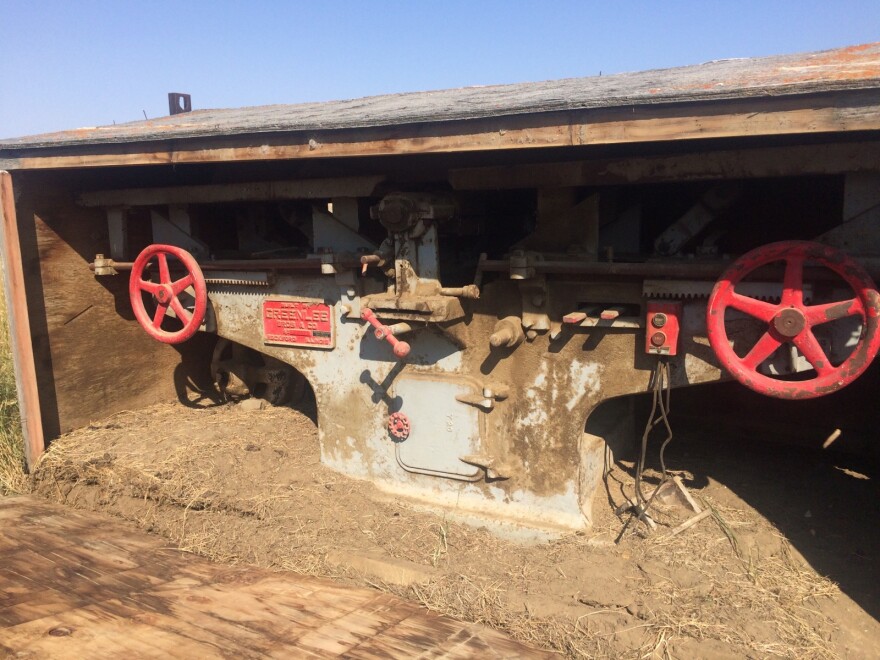A vintage machine built by a Rockford company is joining the permanent collection at the National Museum of Industrial History.
Our story begins in Kalispell, Mont. with Steven Williams. He’s a woodworking enthusiast who owns a “shop” of sorts.
“People come to visit, they say you don’t have a woodworking shop, you have a museum," he said. "And so I buy old vintage machinery and I restore it to factory condition and I use it every day.”
He recently bought a ‘variety woodworker’ machine built by Greenlee, a Rockford-based tool company. Williams says a cabinetmaker had picked it up from a liquidated copper company in 1979.
“Fellow went back to his cabinet shop and built a sarcophagus -- a coffin, a small house -- to entomb the machine. Took it back out with 10 gallons of lard and a wallpaper brush, and he covered the whole machine very well with lard, and he enclosed it, and there it sat until 2018 when he answered my Craigslist ad.”

After consulting with his fellow woodworking enthusiasts, Williams traced the machine’s construction to 1910, and found out that many other copies were melted down for metal during World War II.
“We realized that not only was it rare -- the only one in existence -- but it was the finest example of the type of machine that anyone had ever made,” he said.
After realizing the significance, he reached out to the Smithsonian, which formally accepted the machine into its affiliate, the National Museum of Industrial History.
At the turn of the century, industrial woodworking machines, including this variety woodworker, were connected by belts to a line shaft. This was a large, steam powered rotating cylinder that spanned a factory floor and drove the machines. But this woodworking machine was also quite versatile. Retired Greenlee engineer Keith Moffatt explained.

“In lean manufacturing today they talk about SMED, which is single minute changeover," he said. "The Greenlee brothers were in tune with that back over a hundred years ago and this machine could very quickly be changed over from one mode to another to do different tasks.”
Moffatt notes it takes a clever design to implement this effectively, because these kinds of machines are much more expensive to make than those dedicated to a single task.
The woodworking machine was used from 1910 through the 1970s by the Anaconda Copper Company in Montana. An important use was constructing wooden “patterns.” Mike Piersa is a historian at the National Museum of Industrial History in Bethlehem, Pa. He said patterns are used to create industrial molds.
“You take this wooden pattern, put it into a bed of sand, compact the sand around it, then pull this pattern out. The void that’s left in the sand is then filled with metal and that becomes your finished product.”
The sand is good for a single pour, and the pattern can be used repeatedly to create sand molds with the same physical dimensions.

Anaconda created patterns to cast various gears in its mining equipment. Piersa added that in turn, the woodworking machine helped with company logistics.
“They weren’t going to go shopping back east every time they wanted to build something," he said. "They were going to have their own facility right there in Montana, but they’d have their pattern shop, foundry, machine shop, that actually produce what they need right on the site.”
The variety woodworker also has a connection to Rockford. Its manufacturer, Greenlee, dates back to the Civil War, and slowly transitioned from woodworking, to metalcraft, to electrical tools. Retired engineer Moffatt says this iteration took place even during the woodworking machine’s lifetime.
“A lot of old Greenlee machines that ran off this belt central shaft concept were retrofitted by the customers to run off electricity in the 20s and 30s,” he said.
And even today, Moffatt says Greenlee uses the idea of a “variety” machine in their latest metal shearing equipment.
“It’s very much in the Greenlee DNA, that goes back over a hundred years."
Representatives with Greenlee and Emerson (its parent company) are supportive of the funding, and have asked Williams to work with the Museum to find a way to fund the restoration. Williams hopes to get that done over a six-month period.

“So we can literally look out the window where this machine will be displayed and see the ….carpenter and pattern shop for Bethlehem Steel, so we can tell a pattern shop story, and we can turn 90 degrees and look at the wall of our museum, which is covered with patterns from Bethlehem Steel Corporation and a couple of other manufacturers.”
Once the restoration is complete, the Greenlee variety woodworker will become a permanent part of the National Museum of Industrial History’s collection.

